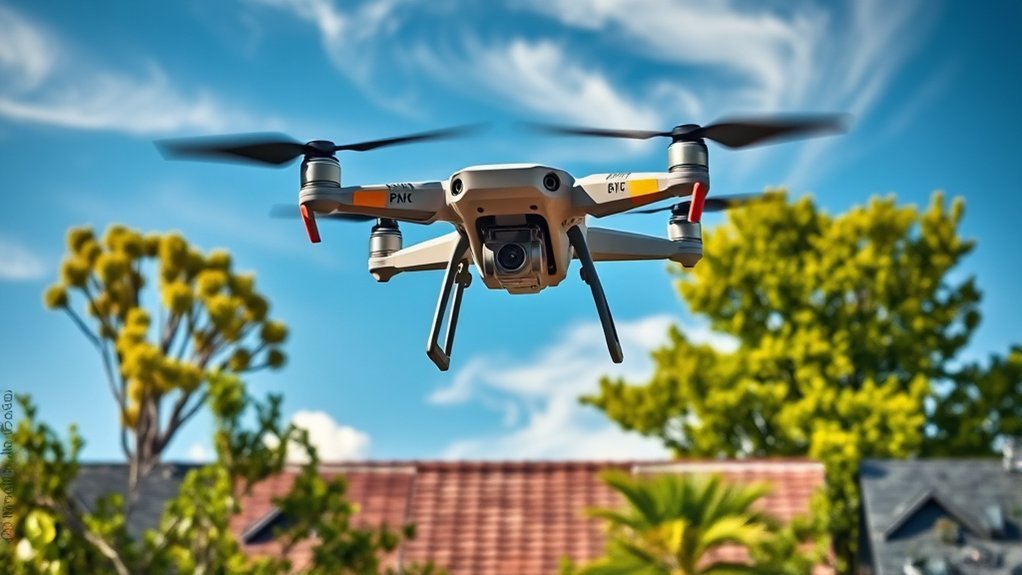In 2025, over 70% of roofing professionals are expected to utilize drones for inspections, greatly improving their workflow. This shift highlights the importance of selecting the right drone for precise imaging and safety. With so many options on the market, it can be tough to determine which models stand out. Let’s explore the top five drones that are reshaping roofing inspections this year.
Potensic ATOM 3-Axis Gimbal 4K GPS Drone
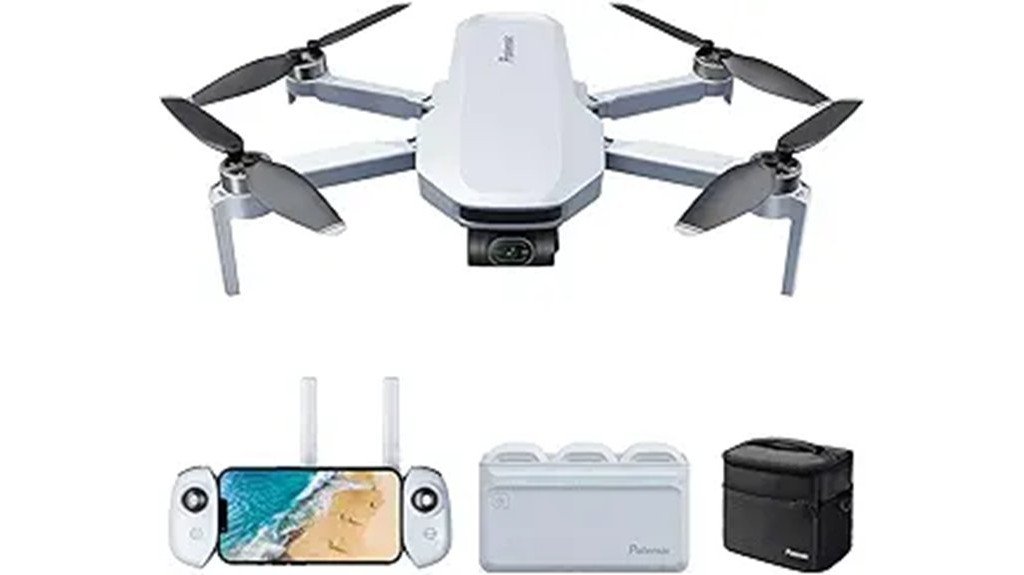
If you’re in the market for a compact and lightweight drone that excels in roofing inspections, the Potensic ATOM 3-Axis Gimbal 4K GPS Drone is an excellent choice. Weighing under 249g, it’s easy to carry and doesn’t require FAA registration. Its 12MP camera and SONY CMOS sensor provide stunning 4K video at 30fps, while the 3-axis gimbal guarantees stable footage even in windy conditions. With a total flight time of 96 minutes across three batteries and a range of up to 6 km, you’ll capture every detail effortlessly. Plus, the included 64GB micro SD card is a fantastic bonus!
Best For: The Potensic ATOM 3-Axis Gimbal 4K GPS Drone is best for hobbyists and professionals looking for a lightweight, portable drone with high-quality video capabilities for aerial photography and inspections.
Pros:
- Compact and lightweight design makes it easy to transport without the need for FAA registration.
- 4K video recording with a 12MP camera ensures high-quality footage and images.
- User-friendly features like Visual Tracking and QuickShots enhance creative filming options.
Cons:
- Limited range compared to some higher-end drones may restrict extensive flight capabilities.
- Battery life could be improved, as 96 minutes may not be sufficient for longer projects.
- Basic remote control may lack advanced features found in more expensive models.
X1 PROMAX 8K Action Flying Camera Drone
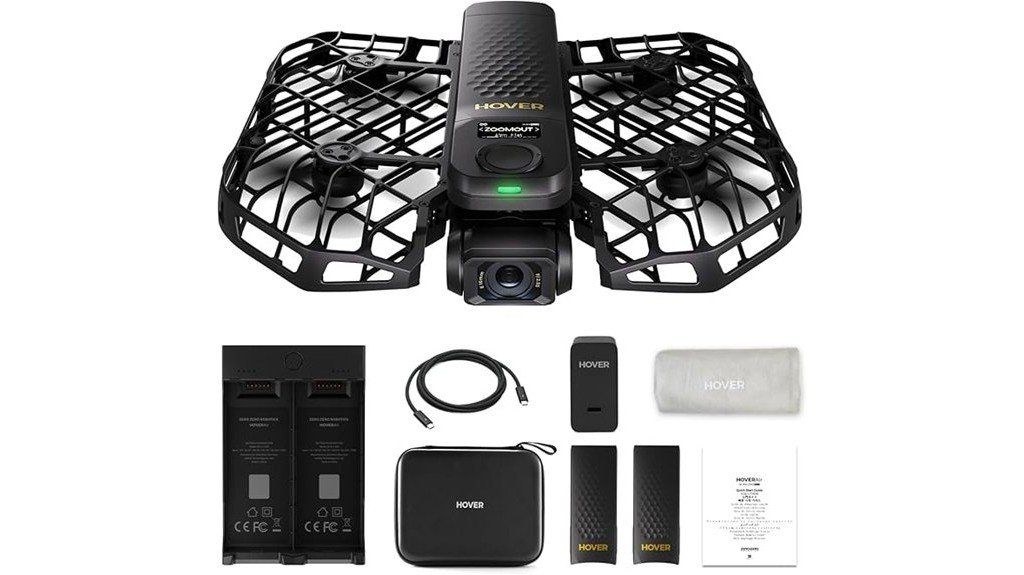
For roofing professionals seeking a versatile tool, the HOVERAir X1 PROMAX 8K Action Flying Camera Drone stands out with its impressive 8K video resolution. With follow speeds up to 42 KM/H and over 10 fully automatic flight modes, you can capture detailed visuals effortlessly. The two-axis gimbal guarantees stable footage, while the OmniTerrain capability allows flights over diverse landscapes. Its foldable design makes it portable, and the advanced collision detection enhances safety during inspections. Control everything through the HOVERAir X1 app, and with 64GB of internal storage, you won’t run out of space for your aerial footage.
Best For: Roofing professionals and aerial photography enthusiasts looking for a high-quality drone with advanced features for capturing detailed visuals.
Pros:
- Impressive 8K video resolution for high-quality footage.
- Over 10 fully automatic flight modes for versatile filming options.
- Foldable and portable design for easy transport and storage.
Cons:
- Weighs 3.67 pounds, which may be heavier than some competitors.
- Limited internal storage of 64GB may require external SD cards for longer shoots.
- Requires app control, which may not appeal to users who prefer traditional remote controls.
DJI Mini 4K Drone with 4K UHD Camera
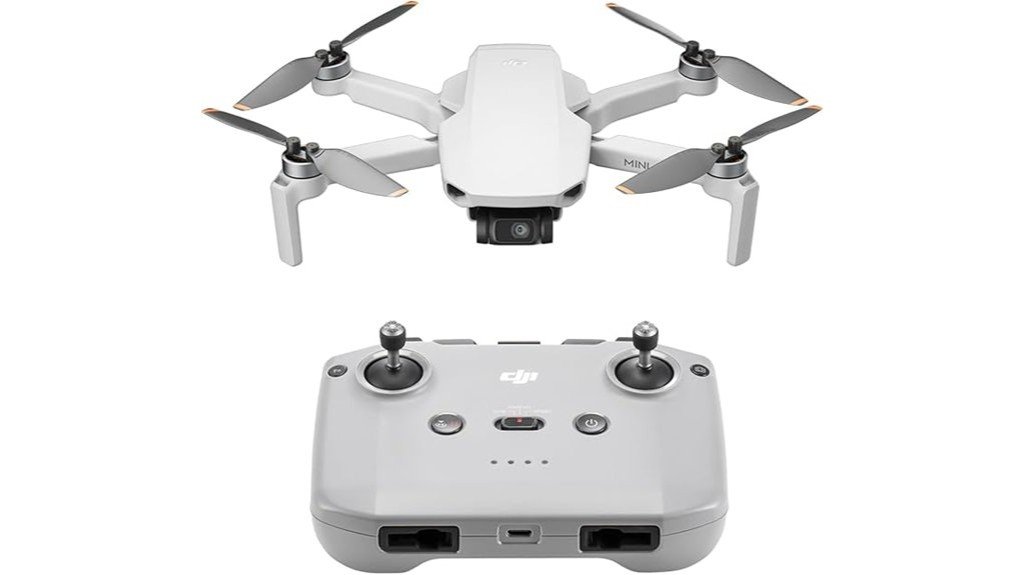
The DJI Mini 4K Drone with its impressive 4K UHD camera stands out as an ideal choice for roofing inspections, especially for professionals seeking high-quality imagery without the hassle of FAA registration. Weighing under 249g, it’s lightweight and incredibly portable. With a wind resistance of 38kph and an altitude capability of 4,000 meters, you can confidently capture stunning shots in various conditions. The 3-axis gimbal guarantees cinematic-quality footage, while the extended battery life provides up to 93 minutes of flight time. Plus, user-friendly features like one-tap takeoff and intelligent flight modes make it perfect for both beginners and experts.
Best For: Professionals seeking high-quality aerial imagery for roofing inspections without the need for FAA registration.
Pros:
- Lightweight design under 249g, making it portable and easy to handle.
- Impressive 4K UHD camera with a 3-axis gimbal for stable, cinematic-quality footage.
- User-friendly features like one-tap takeoff and intelligent flight modes suitable for beginners.
Cons:
- Limited to a maximum wind resistance of 38kph, which may restrict use in adverse weather.
- The need for multiple battery sets to achieve longer flight times may increase costs.
- Some advanced features may require a learning curve for new users.
Ruko F11PRO 2 Drone with 6K Camera

Equipped with a remarkable 6K camera, the Ruko F11PRO 2 Drone stands out as an exceptional choice for those seeking precise roofing inspections. Its advanced image sensor captures finer details and vibrant colors, ensuring exceptional clarity in every shot. With a 3-axis brushless gimbal, you’ll enjoy smooth, stable footage even in windy conditions. The drone offers an impressive 70 minutes of flight time with two batteries, making it perfect for extended inspections. Intelligent GPS flight modes simplify operation, allowing you to focus on capturing professional-level footage without hassle. This drone is a game-changer for your roofing inspection needs.
Best For: The Ruko F11PRO 2 Drone is best for roofing professionals and enthusiasts looking for high-quality aerial inspections and photography.
Pros:
- Superior 6K camera quality captures detailed and vibrant images for precise inspections.
- Long flight time of 70 minutes with two batteries allows for extended use without frequent recharging.
- User-friendly intelligent GPS flight modes make it accessible for beginners while still offering professional-level capabilities.
Cons:
- Optimal performance requires the use of the Ruko charger, limiting charging options.
- Heavier winds may still affect flight stability despite enhanced wind resistance.
- The drone may be pricier compared to basic models, which could be a consideration for casual users.
CHUBORY X10 PRO 5G FPV RC Quadcopter with Camera
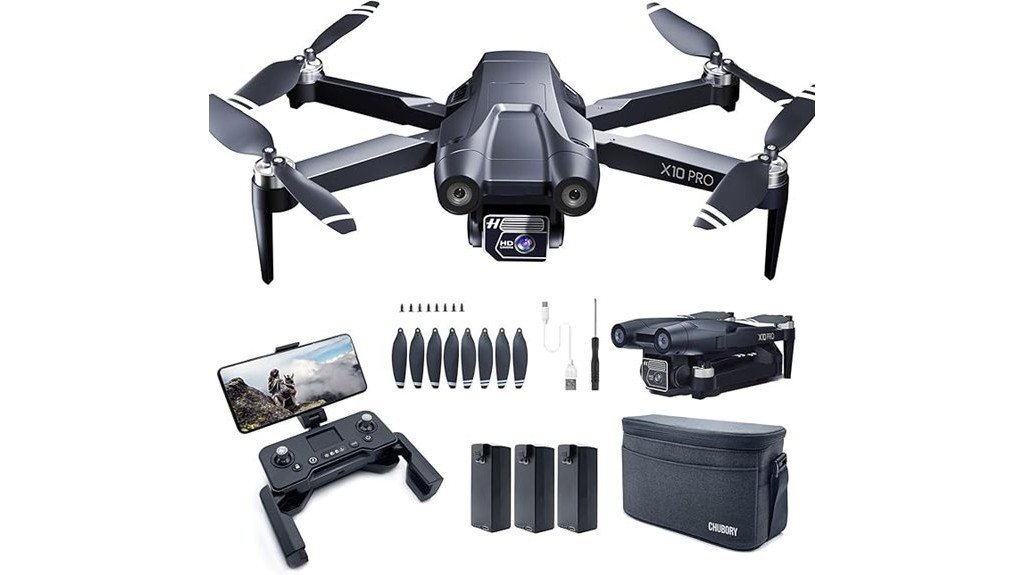
If you’re looking for a user-friendly drone that excels in roofing inspections, the CHUBORY X10 PRO 5G FPV RC Quadcopter is an excellent choice. With its lightweight design and GPS capabilities, this drone features a stunning 4K UHD camera for capturing detailed images and videos. Enjoy a remarkable 90-minute flight time and a control range of up to 3,280 feet. The dual positioning system guarantees stable hovering, while intelligent flight modes like Follow Me and Auto Return Home enhance usability. Plus, with a 1-year warranty and 24/7 support, you can trust this drone for all your roofing needs.
Best For: The CHUBORY X10 PRO 5G FPV RC Quadcopter is best for both adults and beginners looking for a versatile drone for roofing inspections and aerial photography.
Pros:
- High-quality 4K UHD camera for detailed imaging and video recording.
- Long flight time of 90 minutes with a triple-battery system.
- Intelligent flight modes such as Follow Me and Auto Return Home for enhanced usability.
Cons:
- Limited control range of 3,280 feet may restrict usage in larger areas.
- Requires some initial learning for beginners to fully utilize advanced features.
- Weather-resistant design may not withstand extreme weather conditions.
Factors to Consider When Choosing a Drone for Roofing Inspections
When choosing a drone for roofing inspections, you’ll want to focus on several key factors. Camera quality and resolution are vital for capturing detailed images, while flight stability guarantees safe operation. Don’t forget to take into account battery life, weight, and remote control range to maximize your efficiency during inspections.
Camera Quality and Resolution
Choosing the right drone for roofing inspections hinges greatly on camera quality and resolution. A high-resolution camera, ideally 4K or higher, is vital for capturing detailed imagery that allows you to analyze roofing conditions thoroughly. If you want to spot fine details and textures, opt for drones with 6K or 8K video capabilities. These resolutions reveal potential issues often missed at lower levels. Additionally, look for drones with a wider field of view to cover more area in a single shot, reducing the number of flights needed. Don’t overlook low-light performance and advanced image sensors, as these features guarantee you can capture usable images during varying lighting conditions, making your inspections more efficient and effective.
Flight Stability Features
While high camera quality is crucial for capturing detailed images during roofing inspections, flight stability features play a significant role in guaranteeing those images are clear and usable. A 3-axis gimbal is essential, compensating for drone movements and wind disturbances to deliver smooth footage. Look for wind resistance rated at level 5 or higher to maintain stability in variable outdoor conditions, especially on elevated surfaces. Drones with optical flow positioning and GPS stabilization enhance hovering accuracy, allowing you to focus on specific areas of the roof. Advanced collision detection systems, including proximity sensors, further guarantee safety and stability around complex structures. By prioritizing these features, you’ll enhance the effectiveness of your roofing inspections.
Battery Life Considerations
Battery life is a critical factor in ensuring efficient roofing inspections. When you’re selecting a drone, aim for models that provide at least 30 minutes of flight time per battery. This gives you the capability to cover more ground without constant interruptions for recharging. Some drones offer multiple battery options, allowing for extended operation—think 96 minutes with three batteries—greatly improving your efficiency. Look for fast charging features, like the ability to charge several batteries simultaneously, to minimize downtime. Additionally, choose drones that let you monitor battery levels in real-time. This way, you’ll avoid the frustration of running out of power unexpectedly and can complete your inspection tasks smoothly and effectively.
Weight and Portability
When it comes to roofing inspections, the weight and portability of your drone play an essential role in its usability. Look for models that weigh under 249 grams, as they don’t require FAA registration, making transport and deployment easier. A compact and lightweight design is vital for accessing tight or elevated spaces without hassle. Drones with foldable designs enhance portability, allowing you to store them easily in a carrying case or bag. Additionally, choose a drone with a good flight time to weight ratio to minimize battery changes during inspections. A lightweight frame also improves maneuverability, helping you navigate around rooftops and other structures safely and efficiently. Prioritize these factors to guarantee a smooth inspection process.
Remote Control Range
After considering weight and portability, the remote control range of a drone becomes a key factor for roofing inspections. This range determines how far you can fly the drone while keeping a stable connection, with options varying from a few hundred feet to several kilometers. Many drones offer impressive transmission ranges of up to 6 km (20,000 ft), which is beneficial for covering larger properties. However, be aware that environmental factors like buildings and trees can limit your effective range. Advanced transmission systems can enhance reliability, making inspections smoother in challenging conditions. Ultimately, consider the size of the roofs you’ll inspect and the potential for signal interference in urban or rural settings when selecting the right drone.
Safety and Obstacle Avoidance
Choosing a drone equipped with robust safety and obstacle avoidance features is essential for roofing inspections, especially since you’ll be traversing complex environments. Advanced drones come with multiple sensors, like ToF proximity and visual sensors, that detect and avoid obstacles at various speeds and altitudes. This capability greatly reduces the risk of collisions with structures, trees, and other hazards. Additionally, GPS-enabled flight modes, such as Follow Me and Auto Return Home, allow for autonomous navigation while steering clear of obstacles. Look for drones with a sturdy build that can handle windy conditions, as their wind resistance ratings indicate safety in adverse weather. Prioritizing these features guarantees safe operation, protecting both the drone and the property being inspected.
Intelligent Flight Modes
Intelligent flight modes are game-changers for roofing inspections, allowing your drone to navigate complex structures with ease. Features like Follow Me and Waypoint Planning enable your drone to autonomously inspect areas without constant manual control, ensuring thorough coverage. With Tap Fly, you can direct your drone to specific roof spots with just a tap, enhancing your efficiency. The Automatic Return to Home function safeguards your drone against low battery or signal loss, minimizing the risk of damage. GPS-enabled modes provide stable hovering, essential for capturing high-resolution images and videos. Plus, many drones come with additional intelligent modes that improve data collection and visual reporting, making your inspections more effective and reliable.
